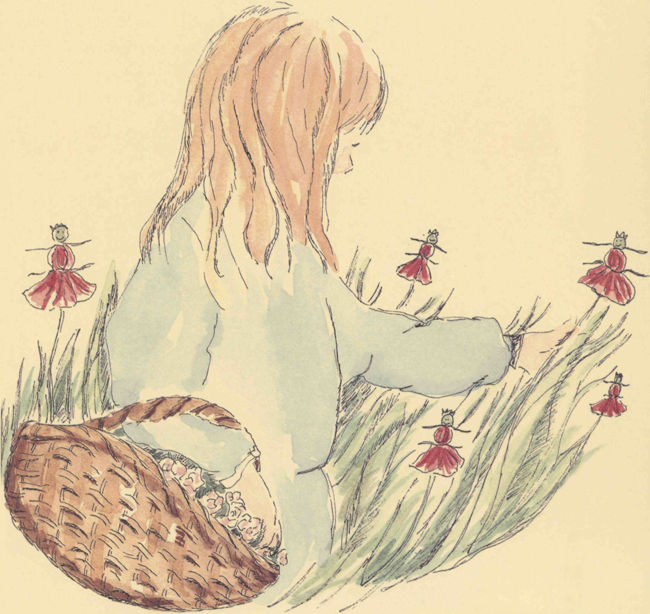
Gretel Hanna Barnitz sat in my Heart’s Ease gardens and shared childhood memories from the 1920s. As a child, she loved to sit beside her mother’s shirley poppy bed and carefully turn down the silky petals of each poppy, exposing the little green seed pods for heads. Then, she would tie a blade of grass around their “waists”, creating graceful, dancing, poppy maidens. “Some afternoons we would spend hours carefully turning and tying all of the poppies in Mother’s side garden,” she said.
“One day Mother called me inside and as I turned to take a last look at my poppy ladies a breeze started stirring through them. All of the poppies began bowing and waving as though they were saying, “Goodbye, thanks for a great day of play!”

Years ago, I quizzed an elderly lady who still spends most of her time in her garden. My usual question, “What did you do with plants when you were a child?” was met with a bright, quick answer.
“We made daisy grandmothers,” she said, smiling as she nodded her head in thought.
“Daisy grandmothers?” I asked, “I don’t recall hearing of those before.”
“Oh,” she said, “that wakens fond memories of spring, when we four sisters would take scissors and a pencil and head out to the meadows searching for the best, fullest field of daisies.”
She explained how the girls would spread out in a meadow and pick a handful of daisies and then “trim their bonnets”. “We would work around the face of the daisy, cutting the petals in the shape of a bonnet,” she said. “Generally, we left two long petals at the bottom of the daisy face. Those would be the bonnet ties. Oh, what great fun we had with our daisy grandmothers!”
Years later, my friend Christine Nybak Hill recounted tales of making daisy grandmothers out in the fields, too. Somehow, through time and continents and generally without benefit of books, our flower traditions are passed on from generation to generation.
I found this poem in a children’s garden book from the late 1800s:
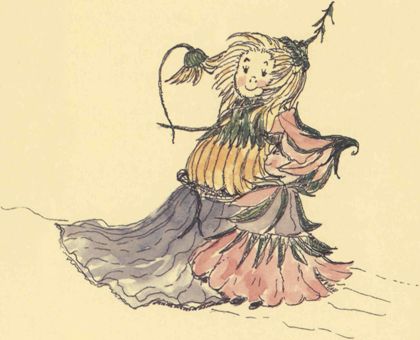
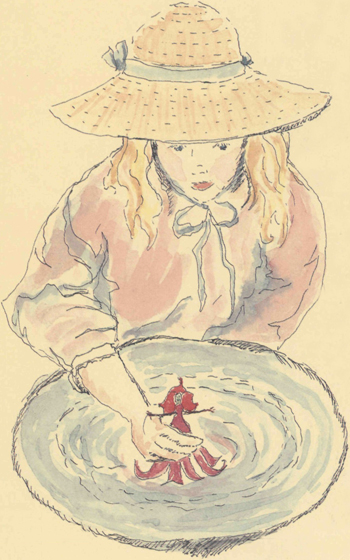
Hollyhock dolls were the plaything most commonly mentioned when I quizzed people about childhood play. “Oh, yes, my sisters and I always made hollyhock dolls,” one lady told me. “There was an unlimited supply of hollyhocks next to our barn. Every morning we would go outside and pick buds and blossoms. We used them stacked on top of each other and held together with twigs. We loved to make them cloaks of violet leaves sewn together with thin strands of grass.
“Our big brother made dolls for us using small cherry tomatoes as heads, but we liked our dolls to be all flowers. Canterbury bell blouses, petunia skirts, these were some of the other flowers we used.”
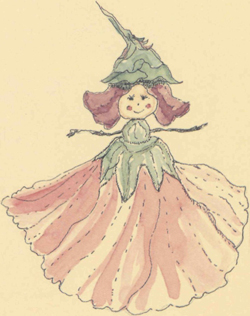
Grab yourself some trumpet flowers and leaves and we’ll work on a doll for you,” Gram said. I reached out and picked two blossoms and a handful of leaves.
Gram turned the bloom with the narrow end up, and stuck a sunny dandelion face into the mouth of the trumpet. Next, she bent a fresh, green leaf over the head and pinned it with a twig. “There, now she has a happy face and a beautiful bonnet,” she said. Finally, we fashioned her a cloak out of one of the leaves, and a peach tree furnished her with twig arms. Gram made a dainty necklace of tiny pink clovers.
“Let’s make her a sister,” I said. “Let’s dress her like a Hawaiian hula dancer,” Gram chuckled, as we tied a long strand of grass around the dancer’s waist. Then, we draped many strands of grass over the waistband and we had a hula skirt.
“Let’s give this gal some dandelion curls on a rosehip head,” she said as we split some dandelion stems, sucked on them, and made curls.
Our trumpet vine dolls danced and played all through a rainy, summer day. In the evening we took them down to the swollen creek and let them float away for an adventure of their own.
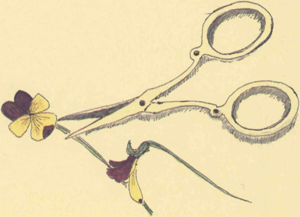
In the 1800s, young ladies would often sit for hours and cut out strings of headless paper dolls. The paper was of two thicknesses; in other words, one piece was folded in half lengthwise, and the dolls cut out with the fold at the top. Then our Victorian friends would slip pansies or Heart’s ease blossoms into place for heads, and the little ladies would be able to stand on their own. When paper was not available, leaves would suffice. They would simply pick a pansy or heart’s ease, fold a leaf around the stem like a cloak, and poke twig arms through for a little pansy leaf doll. A leaf also could be folded in half, like a single paper doll, a hole slit for the head, and a pansy on a stem stuck into the hole.
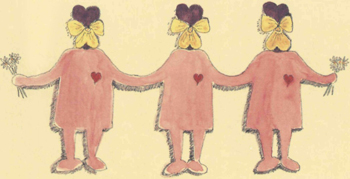
Each pansy has a smiling face
To greet me when I go
To work among them with my spade,
And help to make them grow.
Louise Marshall Haynes
Over the Rainbow Bridge